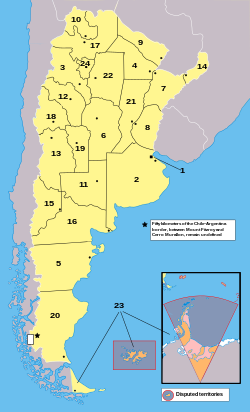Wikijunior:South America/Argentina

Argentina is the second largest country in South America and the eighth largest in the world. It is located between the Andes mountains on one side and the Atlantic Ocean on the other. Argentina and Chile occupy the most southern part of all South America. The country also borders Bolivia, Brazil, Uruguay and Paraguay. Its capital city is Buenos Aires, inside the estuary of Rio de la Plata (Silver River).
What are Argentina's national symbols?
[edit | edit source]

Argentina's official language is Spanish and its national bird is the Hornero. The National Holiday is Revolution Day, which is on May 25th.
What are some famous places in Argentina?
[edit | edit source]
The Plains of Pampas
[edit | edit source]The Pampa (meaning 'plain' in the Native American Quechua language) is a fertile plain around Buenos Aires in Argentina. It is made up of most of Buenos Aires, La Pampa and Santa Fe provinces and also has parts of Córdoba province as well. Parts of the plain extend into the countries of Uruguay and Brazil.
Plants are very simple in this area. They are mostly grasses and low plants, often growing quickly if water is close. Only these small plants grow, as many fires happen on the plain, destroying any other larger plants. Because of these low plants, much of the area is used for feeding cattle or for growing soybeans.
This kind of plain is also called a prairie in North America, a steppe in Europe and Asia, and a veld in South Africa.
The Plateau of Patagonia
[edit | edit source]A marvelous book about Patagonia is titled "IN PATAGONIA" by Bruce Chatwin which tells the story of Chatwin's journey through the entire length of the region during the 1970s.
The Andes Mountain Range
[edit | edit source]What important events have happened in Argentina?
[edit | edit source]The word Argentina means silver in Latin. The country was named after silver because, when shipwrecked Spaniards washed up on Argentina's shore, the indigenous Americans brought them gifts made out of silver.
The rule of Spain
[edit | edit source]Before the European invasion of the Americas, Argentina was rather sparsely populated. Different Native American tribes lived in small villages, and Argentina bordered the Inca empire, but large parts of the country had few inhabitants. The Spanish arrived in 1502 on a voyage of Amerigo Vespucci, the mapmaker that America was named after. Buenos Aires became a Spanish colony in 1580, and was originally a part of greater Peru. It became an important port after 1776 (with the foundation of the "Viceroyalty of the Rio de la Plata"), exporting leather and other goods.
Spain lost control of the region when France defeated Spain in the Napoleonic Wars, and the colonists there became somewhat independent. They even prevented several attempted British takeovers in the early 1800s. On July 9, 1816, Argentina officially declared its independence.
Independence
[edit | edit source]Unfortunately, the new country's first leaders started a civil war that would last several decades. This resulted in a period of anarchy until Juan Manuel de Rosas unified most of the country under the rule of Buenos Aires. He was a tyrant who killed his opponents and anyone who disagreed with him. He attempted to take over Paraguay and Uruguay, and generally developed bad relations with his neighbors. He was overthrown in 1852 with the support of Uruguay and Brazil, and Argentina got its first constitution.
At this time, most people considered "Argentinians" were ethnically Spanish, with Native Americans still thought of as a menace. The country's economy was based on raising animals. Soon Great Britain became more and more involved with Argentina's economy and politics, and Argentina moved towards being a modern country.
The Modern World
[edit | edit source]In the late 1800s, new farming techniques helped improve the lives of Argentinians, and investment by Britain and others helped provide economic wealth. Immigrants came to Argentina from all over Europe, and better roads and railroads were built. The War of the Triple Alliance against Paraguay was bloody and expensive, but Argentina soon recovered and gained new prosperity, mainly due to trade with Europe. Buenos Aires became known as the Paris of the Americas.
What are Argentina's people like?
[edit | edit source]About 41.45 million people live in Argentina. They have backgrounds from many other countries and origins. Almost 88 % of the population comes from Italian or Spanish roots, and Argentinians come from many other countries as well. Fifty six percent of the Argentinians have native roots (different kinds of hybridization); only 2 or 3 % of Argentinians are Pure Native American.
In Argentina, you can often find the influences of many different cultures. Pizza and pasta from Italy are very popular here, but so is native maize and pumpkin. Many Jewish sweets and German dishes are also thought of as part of Argentinian food. Tango originated in Buenos Aires and Montevideo (Uruguay), and is very popular throughout Argentina, though many different musical styles are enjoyed. Argentina is more of a melting pot of various cultures than any other South American country.
Despite all this, nearly everyone in Argentina speaks Spanish, the official language, and most Argentinians are Roman Catholic. About 1 million people a year convert to different religions however.
What sports are popular in Argentina?
[edit | edit source]Although its national sport is Pato Pato, Soccer remains the most popular sport in Argentina. The Argentine Soccer team has won three World Cups, Lionel Messi and Diego Armando Maradona, two of its players, are famous all over the world. Other popular sports include Tennis, Rugby, Polo, Basketball and Boxing.
Who are some famous people from Argentina?
[edit | edit source]Messi and Di Maria.
